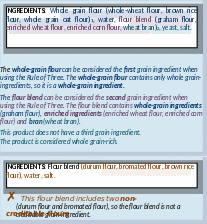Business Respondents
Study of Nutrition and Activity in Child Care Settings II (SNACS-II)
F13_Food Description Guide
Business Respondents
OMB: 0584-0669
F13. Food Description Guide
This page has been left blank for double-sided copying.

OMB Number: 0584-XXXX
Expiration Date: XX/XX/20XX
Food Description Guide
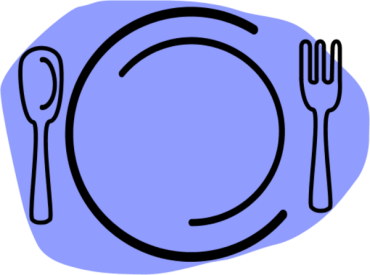
To
be
used
with
the
Menu
Survey
and
the
Infant
Menu
Survey
The
Food and Nutrition Service (FNS) is collecting this information to
understand the nutritional quality of CACFP meals and snacks, the
cost to produce them, and dietary intakes and activity levels of
CACFP participants. This is a voluntary collection and FNS will use
the information to examine CACFP operations. The collection does
request personally identifiable information under the Privacy Act of
1974. Responses will be kept private to the extent provided by law
and FNS regulations. According to the Paperwork Reduction Act of
1995, an agency may not conduct or sponsor, and a person is not
required to respond to, a collection of information unless it
displays a valid OMB control number. The valid OMB control number
for this information collection is 0584-xxxx. The time required to
complete this information collection is estimated to average 0.167
hours (10 minutes) per response, including the time for reviewing
instructions, searching existing data sources, gathering and
maintaining the data needed, and completing and reviewing the
collection of information. Send comments regarding this burden
estimate or any other aspect of this collection of information,
including suggestions for reducing this burden, to: U.S. Department
of Agriculture, Food and Nutrition Service, Office of Policy
Support, 1320 Braddock Place, 5th Floor, Alexandria, VA 22314. ATTN:
PRA (0584-xxxx). Do not return the completed form to this address.
This booklet describes the type of information to include when you are asked to describe food items on the Daily Menu Forms and the Foods You Prepared Forms.
Please refer to the Table of Contents on the following pages to help you find the foods you serve.
Please note that there is also a document that describes how to identify whole grain-rich food items.
If you are also completing the Infant Menu Survey, please refer to the section labeled “Infant Specific Foods” for examples of commonly served infant foods.
Table of Contents
Bread, Bagels, Buns, Rolls
Cereal
Crackers
Muffins
Noodles/Pasta
Rice
Pancakes, Waffles, French Toast
Tortillas
Meat/Meat Alternates 3
Beans
Beef, Pork
Cheese
Chicken
Eggs
Fish
Nuts
Yogurt
Mixed Component Foods 5
Burrito/Enchilada/Taco
Spaghetti
Pizza
Macaroni and Cheese
Soups
Other Foods and Drinks 6
Condiments and Toppings
Dressings and Dips
Water
Whole Grain-Rich Foods 6
Milk
Please provide the following information when describing the milk served:
Fat content
Skim, non-fat, fat-free
1%, low-fat
2%, reduced-fat
Whole
If the milk is flavored, specify the flavor, such as chocolate or strawberry
If you serve lactose-free milk or non-dairy milk alternatives, specify in the “other type” row
Fruits and Vegetables
Please provide the following information when describing fruits and vegetables served:
Form: fresh, canned, frozen, dried, or juice
Chopped, sliced, mashed, blended, etc.
Served with or without skin
Anything added during preparation or cooking (sugar, butter, oil, salt, etc.)
If canned fruit:
was it packed in water, juice, light syrup, heavy syrup, etc.?
If fruit or vegetable juice
Flavor or type
100% juice or juice drink
Sweetened/unsweetened
Regular or low calorie
Calcium or vitamin C added
Brand name
Separate Grains/Bread
Please provide all of the following information when describing separate grains and bread items served.
Reminder: If the food was made from scratch or with two or more ingredients, please complete a “Food You Prepared Form” or provide a copy of the printed recipe.
Bread, Bagels, Buns, Rolls
Type (white, wheat, whole wheat, raisin, blueberry, sesame, etc.)
Brand or manufacturer
Served with spread (butter, jelly, cream cheese, etc.)
Cereal
Hot or cold
Type of cereal
Brand or manufacturer
If served with milk, type of milk (whole, 2%, 1%, skim, etc.)
Crackers
Type (saltine, oyster, cheese, etc.)
Low-sodium or low-fat
Brand (Keebler, Nabisco, Pepperidge Farms, etc.)
Muffins
Type (blueberry, corn, raisin bran, banana, etc.)
Brand or baked from scratch or a mix
Served with spread (butter, jelly, honey, etc.)
Noodles/Pasta
Form (macaroni, spaghetti, rotini, etc.)
Type (regular or whole wheat)
Brand name
If served with sauce, please provide type of sauce and recipe or brand/manufacturer of sauce
Rice
Type (white, brown, yellow, etc.)
Cooking method (fried, boiled, steamed, etc.)
Brand name
Anything added during cooking (butter, oil, salt, etc.)
Separate Grains/Bread continued…
Pancakes, Waffles, French Toast
Type (regular, whole grain, oat bran, etc.)
Frozen, commercial, mix, or from scratch
Brand name
Served with spread: butter, syrup, etc.
Tortillas
Type (flour, wheat, whole wheat, corn, etc.)
Brand name
Plain or fried
Meat/Meat Alternates
Please provide all of the following information when describing meat and meat alternates served.
Reminder: If the food was made from scratch or with two or more ingredients, please complete a “Food You Prepared Form” or provide a copy of the printed recipe.
Beans
Kind (kidney, black, red, lentils, etc.)
Form (fresh, frozen, canned)
Anything added during cooking (butter, oil, salt, etc.)
Beef, Pork
Type (steak, roast, ground, etc.)
Fat content (regular, lean, % fat content)
Cooking method (baked, broiled, fried, pan-seared, etc.)
Was fat trimmed?
If commercially prepared, what was the brand and product name?
Cheese
Type (American, cheddar, Swiss, cottage cheese, ricotta, etc.)
Fat content (whole, part-skim, non-fat)
Form (cubed, sliced, shredded)
Meat/Meat Alternates continued…
Chicken
What part/piece (breast, thigh, drumstick, wing)
Served with skin or without skin
Cooking method (baked, broiled, fried, etc.)
If commercially prepared, what was the brand and product name?
Eggs
Size egg (small, medium, large, extra-large)
Parts of egg used (whole egg, white only, yolk only)
Cooking method (fried, boiled, scrambled)
Anything added during cooking (butter, oil, salt, etc.)
If egg substitute, specify brand
Fish
Type (haddock, sole, catfish, scallops, etc.)
How it was prepared (baked, broiled, pan-seared, etc.)
Anything added during cooking (sauce, butter, oil, salt, etc.)
If canned, whether packed in water or oil
Nuts
Kind (almonds, walnuts, peanuts, etc.)
Type (dry roasted, honey roasted, sugared, salted, no salt, etc.)
Whole, chopped, sliced, etc.
If peanut butter: smooth, chunky, reduced-fat, regular, natural (without added salt, sugar, or oils)
Yogurt
Brand
Type (regular, Greek, etc.)
Fat content (whole milk, low-fat, non-fat)
Flavor (vanilla, peach, plain, strawberry, etc.)
Additions (fruit, nuts, granola, sprinkles)
Mixed Component Foods
Please provide all of the following information when describing mixed component foods served.
Reminder: if the food was made from scratch or with two or more ingredients, please complete a “Food You Prepared Form” or provide a copy of the printed recipe.
Burrito/Enchilada/Taco
If commercially prepared, what was the brand and product name?
Type of meat/meat alternate (bean, beef, chicken, pork, cheese, or combination)
Type of tortilla (flour, corn, wheat, whole wheat, etc.)
Filling (cheese, rice, salsa, guacamole, beans, etc.)
Toppings (cheese, sauce, sour cream, lettuce, tomato, salsa)
Spaghetti
Type of pasta (regular or whole wheat)
Type/brand of sauce (tomato sauce, tomato and meat sauce)
With meat (beef, pork, turkey meatballs, grilled chicken, etc.)
Toppings added (vegetables, parmesan cheese, etc.)
Pizza
Type of crust (thin or thick, white or whole wheat, etc.)
Toppings (pepperoni, cheese, sausage, mushroom, etc.)
Made from scratch, restaurant pizza, or frozen
If commercially prepared, what was the brand and product name?
Macaroni and Cheese
Prepared from a mix, from scratch, or frozen
Brand name
Type of cheese (if from scratch)
If milk added, type of milk (whole, 2%, 1%, skim, etc.)
Anything added during cooking (salt, butter, margarine, hot dog slices, vegetables, etc.)
Soups
Type of soup
Canned, frozen, dry mix, from scratch
Brand name
Low sodium or regular
Anything added during cooking (butter, oil, salt, etc.)
Other Foods and Drinks
Please provide all of the following information when describing other food items, such as condiments, toppings, dressings, dips, and water served.
Condiments and Toppings
Including:
Ketchup, mustard, mayonnaise, BBQ sauce, etc.
Jelly, jam, honey, syrup, etc.
Butter, margarine, cream cheese, sour cream, etc.
Gravy, cheese sauce, etc.
Brand name
Type: low-fat, fat-free, reduced calorie, low-sodium, low-sugar
Dressings and Dips
Brand name or from scratch
Type (low-fat, non-fat, reduced calorie)
Water
Tap or bottled
What was it served in (cup, sippy cup, etc.)
Whole Grain-Rich Foods
Check the “whole grain-rich” box if the food meets the whole grain-rich criteria. If you are unsure whether a food is whole grain-rich, please refer to the USDA guidance provided next.
1

Identifying Whole Grain-Rich Foods for the
Child and Adult Care Food Program Using the Ingredient List
The ingredient list is printed on the food packaging of products. This list includes information on flours, grains, and other ingredients that are in the product. On the ingredient list, the ingredients are listed in order of quantity. If a whole grain is listed first, you know there is more of that whole grain than anything else in the food.
In the United States Department of Agriculture’s Child and Adult Care Food Program (CACFP), you can identify grains that are whole grain-rich by looking at the first three grain ingredients that appear on the ingredient list. This method is known as the Rule of Three. If the ingredient list does not include three grain ingredients, you only have to look at the grain ingredients that are present. Some whole grain-rich foods may have only one grain ingredient.
In the CACFP, at least one offering of grains per day must be whole grain-rich for children and adults. Grain-based desserts may not count towards the grain component in the CACFP, even if the grain-based dessert is whole grain-rich.







Look at the first ingredient
Look for the second ingredient
5
4
Look
for
the third ingredient
Simplify the ingredient list
Find the ingredient list
3
2
1.
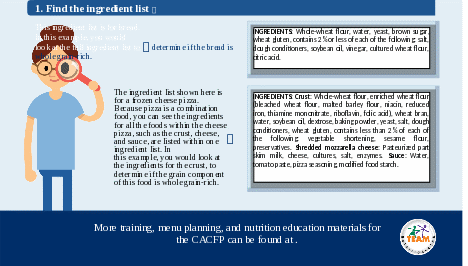



Look at the “Disregarded Ingredients” list below. Do not consider these ingredients. Some sound like grains, so it can be helpful to cross them out at the beginning.
Disregarded Ingredients:
Cellulose fiber
Corn dextrin
Corn starch
Modified food starch
Rice starch
Tapioca starch
Water
Wheat dextrin
Wheat gluten
Wheat starch
Any ingredients that appear after the phrase, “Contains 2% or less of…”
This ingredient list shows some ingredients that can be crossed out to simplify the list.
 Look
at
the
first
ingredient
Look
at
the
first
ingredient
If you have a combination food, like a pizza, look at the part of the ingredient list that refers to the grain product. For this food, the grain product is the pizza crust.
Is the first ingredient a whole-grain ingredient?
Yes: If the first ingredient is whole-grain and the food is not a ready-to-eat breakfast cereal, go to Step 4 below.
Yes: If the first ingredient is whole-grain and the food is a
 The
first
grain
ingredient
is
“whole-wheat
flour,”
which
is a
whole-grain
ingredient.
The
first
grain
ingredient
is
“whole-wheat
flour,”
which
is a
whole-grain
ingredient.
ready-to-eat breakfast cereal, see “Identifying Whole Grain-Rich Breakfast Cereals in the CACFP” on page 4.
✗ No: If the first ingredient is not a whole-grain ingredient, then this food is not creditable as a whole grain-rich food in the CACFP using the Rule of Three.*
✗ No: It is possible that the food includes several whole-grain ingredients. When added together, these grains may meet the whole grain-rich requirement. In this case, you would need to request additional information from the
 manufacturer.
manufacturer.
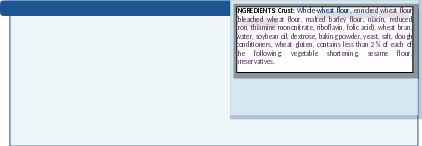 Look
for
the
second
grain
ingredient
Look
for
the
second
grain
ingredient
Does the food have another grain ingredient?
No: If the food does not have any other grain ingredients, you can stop here. The food is whole grain-rich!
Yes: If so, is the second grain ingredient whole-grain, enriched, or bran or germ? Make sure the second grain ingredient is not listed on the “Non-Creditable Grains or Flours” chart.
Yes: If the second grain ingredient is whole-grain, enriched, or bran or germ, see Step 5 on page 3.
The second grain ingredient is “enriched wheat flour,” which is an enriched grain ingredient. For more information on flour made from more than one grain ingredient, see “Focus on Flour Blends” on page 4.
✗ No: If the second grain ingredient is not whole-grain, enriched, or bran or germ, then this food is not creditable as a whole grain-rich food in the CACFP using the Rule of Three.*
This food might be creditable as a grain that is not being served as a whole grain-rich food. See the Food Buying Guide for Child Nutrition Programs (https://foodbuyingguide.fns.usda.gov/FoodComponents/ResourceGrains) for information on how to determine if an enriched grain is creditable towards the grain component in the CACFP.
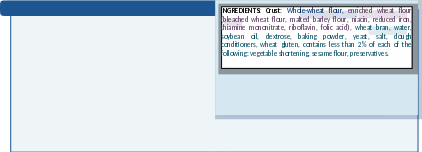 Look
for
the
third
grain
ingredient
Look
for
the
third
grain
ingredient
Does the food have a third grain ingredient?
No: If the food does not have any other grain ingredients, you can stop here. The food is whole grain-rich!
Yes: If so, is the third grain ingredient whole-grain, enriched, or bran or germ? Make sure the third grain ingredient is not listed on the “Non-Creditable Grains or Flours” chart.
Yes: If the third grain ingredient is whole-grain, enriched, or bran or germ, then this food is whole grain-
rich! If your product has other grain ingredients, such as
The third grain ingredient is “wheat bran,” which is a type of bran.
This pizza crust is considered whole grain-rich because the first ingredient is whole-grain, the second grain ingredient is
enriched, and the third ingredient is a type of bran.
Bran
or
Germ
Ingredients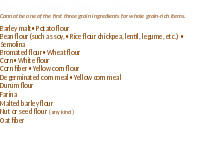
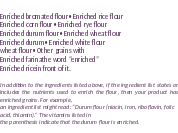


✗ No: If the third ingredient is not whole-grain, enriched, bran, or germ, then this food is not creditable as a whole grain-rich food in the CACFP using the Rule of Three.*
-
Whole-Grain Ingredients
Amaranth
Amaranth flour
Brown rice
Brown rice flour
Buckwheat
Buckwheat flour
Buckwheat groats
Bulgur
Corn masa/ masa harina
Cracked wheat
Graham flour
Instant oatmeal
Millet
Millet flour
Oats
Oat groats
Old fashioned oats
Quick cooking oats
Quinoa
Rye groats
Sorghum
Sorghum flour
Spelt berries
Sprouted brown rice
Sprouted buckwheat
Sprouted spelt
Sprouted whole rye
Sprouted whole wheat
Steel cut oats
Teff
Teff flour
Triticale
Triticale flour
Wheat berries
Wheat groats
White whole wheat flour
Whole corn
Whole durum flour
Whole grain corn
Whole grain corn flour
Whole grain oat flour
Whole grain spelt flour
Whole grain wheat
Whole grain wheat flakes
Whole grain wheat flour
Whole rye flour
Whole wheat flour
Corn
bran Oat
bran Rice
bran Rye
bran Wheat
bran Wheat
germ


You may see an ingredient list that includes a flour blend as an ingredient. The flour blend will be followed by a list of sub-ingredients that make up the flour blend. These sub-ingredients are shown in parenthesis.
Treat these flour blends as one grain ingredient when applying the Rule of Three.
If the flour blend is the first grain ingredient on the ingredient list, then you must determine if the flour blend is a whole grain. If the flour blend is made up of only whole-grain ingredients, then the flour blend is a whole grain. You can now proceed with examining the second and third grain ingredients as described on pages 2 and 3.
If the flour blend includes any grains that are not whole grains, then the flour blend is not considered a whole grain under the Rule of Three.
If the flour blend is the second or third grain ingredient, then the flour blend may be made up of whole grains, enriched grains, bran, and/or germ. If the flour blend includes any non-creditable flours or grains, then the flour blend is not a creditable grain ingredient.
 Identifying
Whole Grain-Rich
Breakfast
Cereals
in
the
CACFP
Identifying
Whole Grain-Rich
Breakfast
Cereals
in
the
CACFP
For ready-to-eat breakfast cereals only, if the first ingredient is whole-grain, and the cereal is fortified, then the cereal is whole grain-rich in the CACFP. Remember to check that the cereal also meets the CACFP sugar limit. For more information on sugar limits for cereal, see “Choose Breakfast Cereals That Are Lower in Added Sugars” at https://www.fns.usda.gov/cacfp-meal-pattern-training-worksheets.
To determine if a ready-to-eat cereal is whole grain-rich:

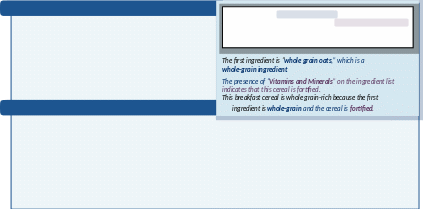
INGREDIENTS: Whole grain oats1, corn flour, sugar, salt, tripotassium phosphate, vitamin E. Vitamins and Minerals2: calcium carbonate, iron and zinc, vitamin C, vitamin B6, vitamin A, vitamin B12.
Look at the first ingredient
Is the first ingredient a whole-grain ingredient?
Yes: If the first ingredient is whole-grain, go to Step 2.
✗ No: If the first ingredient is not a whole grain, then this food is not credible as a whole grain-rich food in the CACFP using the Rule of Three.*
Look for fortification
Is the cereal fortified?
Look for the words “fortified” on the food package. You can also look at the ingredient list to see if it lists any vitamins and minerals that have been added to the product. Cereals that are not fortified would not have any added vitamins and minerals.
Yes: If the cereal is fortified, then this food is whole grain-rich! If your cereal has other grain ingredients, you do not need to consider them.
✗ No: If the cereal has a whole grain as the first ingredient, but is not fortified, then follow the Rule of Three instructions on pages 2 and 3 to look at the second and third grain ingredients.
FNS-655 February 2019
USDA is an equal opportunity provider, employer, and lender.
Infant-Specific Foods
Please provide all of the following information when describing foods specifically served to infants.
Infant Formula
Brand name
Fortified with iron, other vitamins or minerals
Milk-based, soy-based, etc.
Type of formula (powder, liquid concentrate, ready to feed (RTF))
Infant Cereal
Brand name
Type of cereal (hot, cold)
Type of grain (rice, wheat, oatmeal, etc.)
List any foods or liquids the cereal was mixed with
Puffs
Brand name
Flavor of puffs
Baby Food Jars or Pouches
Brand name
Flavor of jar or pouch
| File Type | application/vnd.openxmlformats-officedocument.wordprocessingml.document |
| File Title | SNACS II Food Description Guide |
| Author | MATHEMATICA |
| File Modified | 0000-00-00 |
| File Created | 2022-05-03 |
© 2025 OMB.report | Privacy Policy

